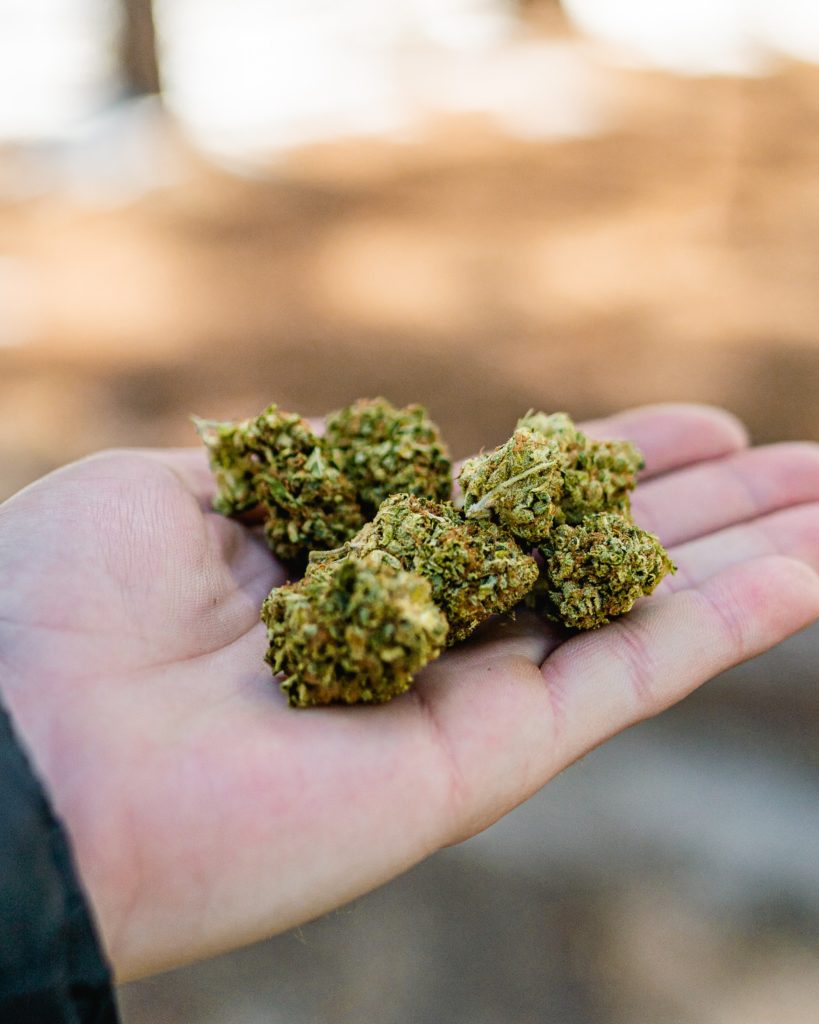Believe it or not, pain relief is the most common reason people seek cannabis! A 2019 study published in Health Affairs showed 62% of medical cannabis patients are looking to ease their chronic pain.
“We now know that chronic pain is indeed the most common qualifying condition for which people obtained medical cannabis licenses. Given the context of the opioid epidemic and the consistent observational studies that report medical cannabis patients substituting cannabis for pain medications, we now have a better sense of how widespread that practice and rationale may be,” said the study’s lead author, Kevin Boehnke, PhD.

Cannabis and the opioid crisis
It’s no wonder why people are putting down the pills and picking up the hippie green plant instead. When it comes to abusing opioids, there’s a common justification: “My doctor prescribed me this medication. Therefore, I am not addicted.” It’s an easy lie to believe because your doctor did prescribe you that pill. Why would they give you something that could hurt you?
It’s important to keep in mind, just because something is prescribed to you by a physician, doesn’t mean it comes without risks. Check out some of these sobering statistics from the U.S. Department of Health and Human Services about opioid misuse:
- In 2019, it’s estimated that 10.1 million people aged 12 years or older misused opioids over the prior year. Specifically, 9.7 million Americans misused prescription pain relievers, while the remaining 745,000 people used heroin.
- More than 760,000 Americans have died since 1999 from a drug overdose. Two out of three overdose deaths in 2018 involved an opioid.
- The national rate of opioid-related hospitalizations was 297 per 100,000 population in 2016.

Can I overdose on cannabis?
Currently, cannabis has not been proven to be the cause of any fatal overdose.
This set of parents, for example, tragically lost their 22-year-old son unexpectedly. They firmly believe cannabis was responsible for their son’s death, as it was found in his system when he died and he was an advocate for the plant. Despite this belief, the examiner who conducted his autopsy concluded cannabis did not cause his death, and doesn’t list it as the cause of death on his death certificate. While experts might point out other side effects to watch out for after consuming cannabis, such as paranoia, racing heart, potentially distorted vision, etc., nearly all of them agree that overdosing on cannabis just isn’t possible. This pair of grieving parents, unfortunately, did lose their son to a heart attack, according to the examiner.

What does science say about cannabis for pain relief?
So far, the FDA has not approved cannabis to cure or treat any disease, and that includes chronic pain. With that being said, there is an enormous amount of research and anecdotal testimonies that support cannabis for pain relief. This research sparked the installation of medical cannabis programs in over half the country, with surely more to follow! In terms of credible research rooted in scientific processes, here’s what we know about cannabis and pain so far:
- A 2016 research paper discovered cancer patients used 64% fewer opioids for cancer-related pain when medical cannabis was integrated into their routine.
- This piece of research also notes:
- Cannabis consumption was associated with a better quality of life in patients with chronic pain
- Cannabis came with fewer side effects and medications used
- This piece of research also notes:
- Harvard University says cannabis seems to ease the pain associated with multiple sclerosis, as well as general nerve pain.
- This 2015 review exploring cannabis to relieve pain found several of the conducted trials yielded positive results. The trials focused on patients with chronic pain, neuropathic pain, and multiple sclerosis. “Marijuana or cannabinoids may be efficacious for these indications,” reads the study.

How does cannabis for pain relief work?
Let’s first talk about cannabinoids like the above study briefly mentioned. Cannabinoids are compounds found in the cannabis plant; there are over 100 known ones, but you might know the most popular ones as CBD and THC. To keep it simple, THC is the compound responsible for creating a high. CBD won’t intoxicate you, but it’ll give you a lot of the same benefits THC does!
Once these cannabinoids enter the body, they meet something called the endocannabinoid system. The endocannabinoid system is a biological system every human being has. The endocannabinoid system is equipped with receptors, CB1 and CB2 receptors to be specific, and they interact with cannabinoids like THC and CBD.
THC fits the CB1 receptor perfectly. You’ll find heavily concentrated areas of the CB1 receptors in the brain stem, spinal cord, nervous system, and other parts of the body. The CB2 receptor engages a lot with CBD, but they don’t directly fit each other like CB1 and THC. Find CB2 receptors in our vital organs, immune cells, the brain, our skin, digestive system, and more.

The endocannabinoid system continued
Experts believe the endocannabinoid system is responsible for bringing our body to homeostasis and restoring balance in the areas where we need it the most. That’s why you hear people recommending cannabis for so many different issues: because we have endocannabinoid receptors in basically every part of our body! Cannabinoids are a direct target to those receptors.
Don’t believe us? We don’t blame you, because you haven’t heard much about the endocannabinoid system. Modern medicine doesn’t talk about it, much less make it a part of their treatment plan. However, universities like UCLA have even devoted an entire research initiative to the endocannabinoid system, with plenty of content to learn from already! We also mentioned Harvard’s opinion on cannabis for pain relief in the above section highlighting credible pieces of research. So yes, the endocannabinoid system exists and there’s thorough research to prove it!
But no, you probably won’t hear about it from your doctor unless you ask. That’s not necessarily the doctor’s fault, though. Cannabis is still federally illegal to this day, despite over half the country legalizing it in some fashion. This makes things infinitely harder for physicians, whether it’s a professional stigma or they simply don’t have the necessary research that federal funding would be able to provide.

How do I consume cannabis for pain relief?
This is a great question, because there isn’t just one answer! Typically, when people (new consumers) think of cannabis, they think of smoking it. Thankfully, that’s not the only way to get your daily dose of cannabinoids. Smoking isn’t ideal for people with asthma or those who are uncomfortable inhaling smoke. Cannabis is versatile, so the way you consume it can be, too! Here are some of the best ways to try it if you don’t want to smoke:
- Grab an infused-bite from award-winning edibles company, incredibles
- Use a topical! Cannabis-infused topical products target the endocannabinoid receptors in our skin to offer direct relief for pain, like this fast-acting Extra Strength Salve from Quiq.
- Try a CBD product. Hemp-derived products like this chocolate bar from trupura CBD are a great option for people who don’t want to consume THC!

Explore different types of pain relief and shop online through Medically Correct! We always recommend consulting with an educated physician who knows your medical history before proceeding. Consider speaking with a licensed, cannabis-trained nurse at Leaf411 for a free evaluation.
